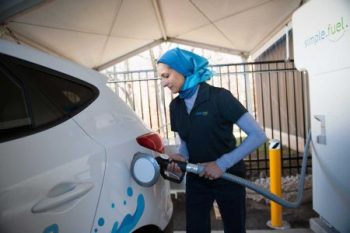- November 14, 2016
- Posted by: Catalyst
- Category: Business Energy News

The application sales engineer at PDC Machines, Nihad Kaiseruddin, demonstrates the SimpleFuel device. This prototype powers electric fuel-cell vehicles with high-purity hydrogen derived from a combination of water and electricity.
Some may call this magic, however, it’s no parlor trick. Inside this 8-foot-tall steel box, water is being converted into clean hydrogen motor fuel at a Bucks County industrial park. This device, dubbed the SimpleFuel machine, uses electricity and water to produce almost 100% pure hydrogen.
A consortium of three companies has operated the SimpleFuel machine since September, to power electric fuel-cell vehicles at PDC Machines Inc. PDC is an industrial manufacturer located near Warminster.
The vehicles being used here will produce only water vapor emissions thanks to the SimpleFuel machine. This elusive goal has been an industrial challenge for clean-energy advocates. Ideally, PDC hopes to provide motorists with many of the conveniences their conventional gasoline counterparts have, such as long-range and quick refueling. These have been hard to obtain for plug-in electric vehicles.
Our aim is to have zero emissions with zero compromise, the vice president of business development for PDC Machines said. You can travel nearly the same distance as a gasoline vehicle, and refuel within three to five minutes, Kareem Afzal concluded. PDC, the company Afzal works for, manufactures the gas compressors that are a critical part of the SimpleFuel device.
The U.S. Energy Department named the SimpleFuel machine the sole finalist for the $1 million prize in the H2 Refuel H-Prize Competition this past January. The aim of this contest was to incentivize American innovators to create a small hydrogen generation system, in order to improve hydrogen fuel technology.
We believe this technology has the ability to make fuel-cell vehicles the norm, the SimpleFuel project’s team leader, Darryl Pollica said. He is also the head of Ivys Energy Solutions, located in Waltham, Massachusetts.
The National Renewable Energy Laboratory is currently giving the hydrogen producing and dispensing machine a three-month evaluation. This will determine whether SimpleFuel meets the contest’s technical, cost, and safety criteria.
PDC’s SimpleFuel device will be available for public viewing Wednesday, at their plant, located on Stout Drive in Warwick Township, Bucks County. This will include a demonstration of the refueling process. The vehicle to be used for the demo will be a Hyundai Tucson SUV, that has been outfitted with a fuel-cell power system.
The device works because it marries conventional technology in a compact package, the SimpleFuel team reports. Much of their effort involved cramming the critical systems into an 8-foot-tall beige box, that comes pre-installed with a fuel nozzle.
The idea was to make something that looked approachable, rather than like a chemical plant, Afzal said. We thought it was very important to make the shape look cool.
Hydrogen can be produced from different sources, such as electricity and water, or natural gas. The SimpleFuel team wanted to use electricity as the energy source, however, due to the system’s potential of being able to produce carbon-free fuel. The electric route also has the capacity to work well with renewable solar or wind power energy sources.
The SimpleFuel team refers to the refueling device as an appliance. It includes an electrolyzer that uses electric currents to convert water into oxygen and hydrogen gases. The oxygen generated this way is vented into the atmosphere, and the hydrogen is purified then stored under tremendous pressure in a carbon-fiber tank.
A third partner in the consortium, McPhy Energy North America, supplied the electrolysis technology. They are a subsidiary of a European hydrogen company.
The appliance can keep up to 5 kilograms (11 pounds) of hydrogen stored on board. This is sufficient enough to give a single 350-mile fill-up to a fuel-cell vehicle. In this equipped vehicle, the hydrogen and air are mixed to create a chemical reaction within a fuel cell, that will generate electricity. After purification, the hydrogen is emitted as water vapor.
In the hydrogen economy, this is kind of the holy grail, Pollica said.
Although hydrogen is widely used in industrial applications, it has been stigmatized in the eyes of the public by the 1937 Hindenburg airship disaster. The challenge for the fuel-cell industry, Afzal said, will be to educate the public that hydrogen is safe.
The gas compressor technology squeezes the hydrogen to about 10,000 pounds per square inch. This is the standard that vehicle manufacturers want to achieve, in order to keep the onboard fuel tank at a manageable size.
The founder of PDC Machines is Kareem’s father, Syed Afzal. He is a chemical engineer who emigrated from Hyderabad, India, to attend Princeton University. Syed Afzal started the business in a garage, and it now employs over 60 people at two plants located in the Warwick Commons industrial park.
The company generates about $20 million annually, by selling gas compressors and various equipment to some of the world’s largest industrial producers, PDC’s president said. We’re proud of the fact that our products are 100% made in the U.S.A. Syed Afzal concluded.
The company recently received a three-year order to export 100 compressors to China, in order to fill fleets of hydrogen-fueled buses and delivery trucks.
The SimpleFuel device will initially cost around $150,000 to $200,000 to produce. While this is not economical for most individuals, it is potentially attractive for groups of motorists or car-share businesses. Despite this, Afzal stands behind the claim that the hydrogen fuel business represents a potential breakthrough for PDC.
In four to five years, our annual sales will hopefully grow to $60 million plus, Afzal suggested. PDC is talking with other machine shops, in an attempt to negotiate the supply of parts. The company is also looking to expand into a vacant property in the industrial park, to build their third plant.
